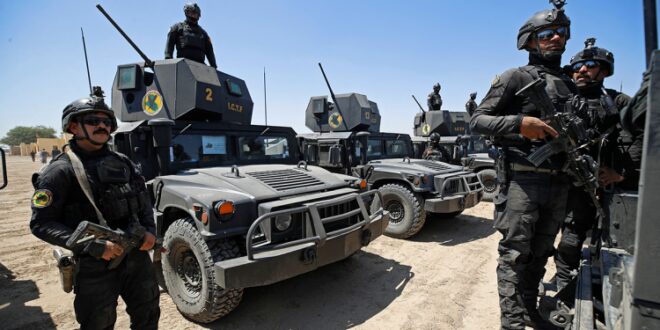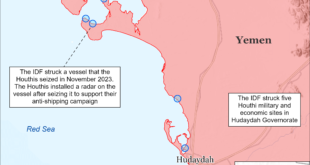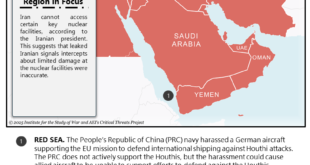For the past several years, US interests have drifted away from the wars in Iraq and Afghanistan to focus on national security issues in the Pacific and — now — Europe. Unfortunately, the security situation in the Middle East and events like Hamas’ Oct. 7 attack, strikes by Iranian-linked groups on US troops, and Houthi attacks on shipping in the Red Sea continue to pull US attention back to the region.1
Iraq has once again reemerged as a central battleground in the turmoil in the Middle East. Iranian-supported militia groups target US troops in the country in response to US government actions, with the US responding in kind.2 The threat of the Islamic State remains.3 Iranian influence in Iraq has expanded through Iranian-backed militias within the country.4 The Higher Military Commission (HMC), a joint dialogue with the Iraqi government to discuss the future of the coalition forces combating the Islamic State, is intermittently ongoing. At the same time, bilateral discussions between the US and Iraq’s government are likely occurring as well.5
Of the many issues discussed during these talks, we should not overlook ensuring a continued relationship between the US Special Operations Forces (USSOF) and the Iraqi Counterterrorism Service (CTS). The CTS, an organization built and supported by the US and with a strong partnership with USSOF, is a critical, enduring strategic partner in the region. It is the most significant and capable counterterrorism force in the Middle East. While it faces challenges, as outlined in the latest Lead Inspector General report on Operation Inherent Resolve, including reliance on coalition forces for some intelligence, surveillance, and reconnaissance and varying levels of effectiveness across the country,6 the CTS will be essential in maintaining pressure on the Islamic State and can prevent, or at least limit, the US from further strategic distraction in the Middle East. The CTS has long been a strong US partner, and the force’s capability strengthens a sovereign Iraq beset with challenges from militias acting outside the Iraqi government’s control. The US must prioritize a continued USSOF relationship with the CTS, deliberately plan to maintain the relationship, and learn from our past experiences to create a genuinely effective long-term counterterrorism partnership.
The CTS is a strategic hedge against violent extremist organizations in the Middle East
Continued partnership with the CTS is critical to maintain adequate pressure on the Islamic State. While degraded since the loss of its territorial caliphate in 2019,7 the threat of the Islamic State’s reconstitution remains. In January of this year, the Islamic State claimed an attack in Iran that killed almost 100 people and wounded more than twice that number8 — the deadliest terrorist attack in Iran in decades.9 The group’s Afghanistan-based offshoot, Islamic State-Khorasan Province (ISKP), has been assessed as responsible for the attack,10 indicating ISIS affiliates are still capable of executing some form of external operations.
US senior leaders also assess that the Islamic State’s core group in Iraq and Syria “desire to strike beyond the Middle East.”11 Last April, the US military killed two Islamic State leaders in Syria, one reportedly planning attacks in Europe and Turkey with the other plotting to kidnap government officials abroad to gain leverage.12 The CTS reportedly disrupted a planned attack against the United Kingdom last summer by conducting a raid that killed five senior Islamic State leaders, discovering connections between the leaders and British nationals, and passing the information to British intelligence agencies.13 The Islamic State claimed credit for an attack on a Roman Catholic church in Turkey at the end of January.14
Within Iraq and Syria, the risk of the Islamic State’s potential resurgence remains. Some believe the organization has already gained ground, taking advantage of a region in turmoil.15 Others have expressed concerns about the repercussions of ending Western counterterrorism pressure. Charles Lister, a regional expert at the Middle East Institute, wrote in Foreign Policy last month that a US withdrawal “would trigger chaos and a swift surge in terror threats.”16
A resurgent Islamic State is in no one’s interest. For Iraq and other countries in the region, it would add additional threats to an already fragile security landscape. Arguably, an emboldened Islamic State allowed to resume external attacks against the West would again become a strategic distraction for the US and its Western allies trying to rebalance Middle East regional threats while focusing on other pressing geostrategic interests.
The key to maintaining pressure on the Islamic State in Iraq will be the CTS. It was the only Iraqi security force not to collapse in the face of Islamic State’s rise in 2014 and was vital in liberating Iraqi cities like Ramadi, Fallujah, and Mosul, overrun by the group. But the unit’s success took its toll. Rather than being employed as a precision counterterrorism instrument, the reliable soldiers of the CTS fought as light infantry shock troops in the streets of Iraq’s Islamic State-occupied cities.17 Many CTS soldiers were lost or injured in the brutal fighting, and today’s CTS is still recovering.18 It is slowly regenerating combat power, recruiting new members, and strengthening its capabilities. Maintaining a USSOF relationship with the organization, advisory efforts, and US government support is an economy of force effort, a small cost to offset a far more negative outcome.
The US has a Strong Partnership with the CTS
Not only is the CTS a capable force, but it is also one of the most vital US partnerships in the region. The Iraqi forces that make up the CTS have had a 20-year relationship with the US. When created in May 2004, the Iraqi Special Operations Forces (ISOF) was a merger of two multi-ethnic units built by USSOF to conduct operations on a “non-sectarian and non-political” basis.19 During the fight against al-Qa’eda in Iraq, USSOF and ISOF soldiers lived, trained, and fought together, developing strong bonds on the battlefield. We used the same practice during combat operations to dislodge the Islamic State from Iraq. When we responded to the threat of ISIS in 2014 — we built the eventual Iraqi response around the CTS — they were the core force that held things together to buy time for the rebuilding of the Iraqi Army. Generations of CTS and USSOF leaders have built personal relationships, working together for common goals across these different conflicts.
That close relationship means that ISOF soldiers and leaders inculcated USSOF standards of professionalism and proficiency in conducting precision counterterrorism operations. Concepts like empowering junior officers and non-commissioned officers and foundational ideas that make USSOF such a capable force were also adopted by CTS soldiers, as was the idea of a non-sectarian force working in the best interests of a sovereign Iraq.
The CTS is also arguably one of the most successful counterterrorism partnership efforts undertaken by the US. While the US has provided approximately $800 million in equipment through programs like the Counter-ISIS Train and Equip Fund – Iraq (CTEF-I) and Iraqi Security Forces Fund (ISSF) over the past 21 years, that accounts for just under 3% of the $28.4 billion requested or appropriated through the same programs for training and equipping security forces in Iraq.20 Additionally, the total funding the US has provided the CTS over 20 years amounts to less than 2% of the $44.2 billion in military assistance provided to Ukraine in the past two years.21
With this relatively small investment, the US has helped build the most potent counterterrorism force and the most trusted, non-sectarian security force in Iraq. In a region still wracked with turmoil, where US national interests are at stake, we would be shortsighted not to prioritize continued support for this critical, enduring, strategic partner.
A Strong CTS Strengthens a Sovereign Iraq
Iranian-backed militias within Iraq’s Popular Mobilization Forces have strengthened Iranian influence within the country and, to some degree, within its security institutions. Since October 2022, individuals associated with Iranian-supported militias have occupied key positions within the Iraqi National Intelligence Service (INIS) and the National Security Service (NSS), among other entities.22 This placement has not been the case with the CTS. The CTS’s professional ethic and non-sectarian nature, forged alongside USSOF counterparts, have held. The Service’s close relationship and partnership with USSOF and its successes in defeating the Islamic State have given the organization stature and helped insulate it from this influence,23 although it may come under increasing pressure if tensions with the U.S. continue to rise inside Iraq.
Additionally, Iraq’s outlaw militia groups like Kata’ib Hezbollah (KH), Asa’ib Ahl al-Haq (AAH), and Harakat Hezbollah al-Nujaba (HAN) have degraded Iraq’s sovereignty by acting outside the control of the Iraqi government. With the US urging the Iraqi government to rein in these groups, the CTS represents the only viable security force the Iraqi government would have to attempt to control the militias.
This situation has a historical precedent. In 2008, as the government of Iraq struggled with Jaysh al-Mahdi and Iranian-supported Special Groups, CTS forces responded. They conducted operations in Sadr City and Basra and targeted Special Group leaders.24 In 2020, in a precursor to today, outlaw militia groups in Iraq targeted US bases in the country in response to the January 2020 killing of then-Quds Force Commander Lt. Gen. Qassem Soleimani. In March 2020, after a then-unprecedented 22 strikes and the deaths of two American and one British soldiers, the US launched retaliatory airstrikes against the militias in Iraq.25 In May 2020, Iraq’s then-newly appointed prime minister, Mustafa al-Kadhim, who signaled his intent to bring armed groups under control, faced the same challenges the current Iraqi government faces.26 After a spate of attacks in May and June, two of which targeted the US Embassy,27 Prime Minister Kadhim directed the only force available to act against the groups operating outside government control. On June 26, the CTS arrested 14 members of KH preparing rocket attacks against the US Embassy, a move cited by some as extraordinary given the impunity with which KH had operated.28
While KH’s political power secured the release of its members, the episode highlights the importance of the CTS as the only force within Iraq capable of supporting the Iraqi government in bringing outlaw militia groups under government authority.29 If the current Iraqi government summons the political will to rein in these groups, the CTS will be the action arm. Continued US partnership with the CTS is not just in the US national interest but also in the interest of a sovereign Iraq.
What, then, should we do to support this critical partner?
First, maintaining the CTS/USSOF relationship should be foundational to US and Iraqi government bilateral engagements and the ongoing HMC. While a single partnership is a seemingly minor point in such significant geopolitical discussions, the strategic implications of degradation in a USSOF relationship with the CTS are immense. The CTS must be supported and enabled to wage an operational campaign against the Islamic State. Put simply, if Western-backed counterterrorism pressure recedes, a resurgent Islamic State is inevitable. A CTS marginalized by Iranian-aligned actors would have the same harmful effect. In the worst case, a CTS infiltrated by those same actors would be a malign vehicle for training Iranian-affiliated militia groups, possibly exported throughout the region. On the other hand, a CTS partnered with the US and supported by USSOF prevents these outcomes and serves as a strategic advantage in an unsettled and volatile region.
Second, the US must deliberately plan for multiple mechanisms to support the CTS in the future. With the future outcome of bilateral engagement with Iraq and the HMC unclear, we should devise plans for USSOF support to come under Title 10 authorities through a named military operation such as Operation Inherent Resolve or under Title 22 authorities through security force assistance efforts with the Office of Security Cooperation – Iraq (OSC-I). In 2011, the USSOF community planned to remain in Iraq, supporting partners like the CTS. While then-Prime Minister Nouri al-Maliki wanted US troops to stay in an advisory capacity, political differences ultimately prevented an agreement from being reached, and US troops withdrew by the end of 2011. USSOF planners, believing a complete withdrawal was a “throw-away course of action,” were caught off guard, and the hasty transition to OSC-I-led training support degraded the US partnership with the CTS.30 While US military leaders may feel confident that US troops can remain in Iraq, another unplanned hasty withdrawal is conceivable should the government of Iraq give in to growing internal political pressures building from US retaliatory strikes in Iraq.31
Third, USSOF must learn from past mistakes. As mentioned above, we must learn lessons from the USSOF experience of leaving Iraq in 2011. Coming full circle, we cannot afford to abandon this strategic partner again. We must also learn from the USSOF advisory experiences in Afghanistan. A detailed Special Inspector General for Afghanistan report released last year captures many critical failures of our advisory missions in Afghanistan. Issues such as prioritizing short-term security assistance over long-term security cooperation and ineffective civilian-military coordination stymied the development mission in Afghanistan, as did a lack of focused advisory training for incoming ministerial advisors. The report notes that a lack of continuity across deployments was “one of the great failures” in the advisory effort.32 USSOF must learn from these past failures to prevent future strategic setbacks.
In 2010, then-Secretary of Defense Robert Gates wrote in Foreign Affairs that the “strategic reality demands that the US get better at … building partner capacity.”33 Those words are as accurate today as they were when they were written. The strategic reality remains the same: The US faces multidimensional global threats to a stable political order, and many priorities are competing for the attention of policymakers and military leaders. In this strategic reality, we require strong partnerships. A robust and enduring partnership with the CTS can help mitigate risks and be a stabilizing force for a sovereign Iraq. An enduring partnership between USSOF and the CTS is in best interests of both the US and Iraq. Ensuring this should be a priority in discussions of future relationships, and the US must find ways to learn from its past mistakes and establish an effective long-term partnership with the CTS.
 Eurasia Press & News
Eurasia Press & News



